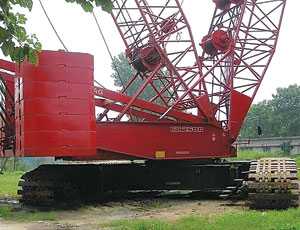Buyers should beware of construction cranes that have not been inspected by an expert source, say original-equipment manufacturers after discovering fakes and taking legal action against manufacturing pirates. At least three separate cases of Chinese-made counterfeits have surfaced in the past six months.


“We have two issues: One is that a company is infringing our rights, and the other is that we think it really is affecting safety,” says Klaus Meissner, director of product integrity for Terex-Demag in Zweibrucken, Germany. Though he says Terex has initiated “some legal proceedings” against a Chinese company, Meissner would not say which one.
Over the past year, Terex has identified at least eight crawler cranes in China’s Henan Province being passed off as Demag originals. In all cases, the cranes were labeled as Demag model CC2500. Produced since 2001, the genuine article is a 500-ton-capacity machine costing about $3 million. “It’s neither a toy in terms of cost nor safety,” says Meissner.
Another German crane supplier, Liebherr, identified a fake model LR1280, normally a 300-ton crawler, in India last year. The owner “thought he had bought a secondhand Liebherr crane and was ordering spare parts based on the serial number,” says Gerold Dobler, spokesman for Liebherr in Biberach. The number turned out to be a forgery. More reports this year of Chinese-made fakes advertised as Tadano truck cranes in the Middle East also have raised concerns. Tadanos carry parts made in Germany and Japan.
To the untrained eye, counterfeits are not always easy to spot. Photos obtained from Terex show what appears to be one its red cranes. But Meissner says the fakes have a modern crawler undercarriage mated to a lattice boom designed for an older model. In some cases, the sizes of the diagonal braces were also a red flag.
The primary concern is that the cranes could fail, harming people as well as the trademark owners’ goodwill. “We have to warn, otherwise we might be in deep trouble,” Meissner explains. “If something would happen to such a crane in the U.S. or India, the first thing I would see on the cover of a magazine is a picture of the crane—with our name across the boom—lying on a school bus. This is the kind of publicity we do not want to see.”
So far, all of the recent cases have been outside of the U.S. But as manufacturers expand their reach, the threat grows. “I think one has to be concerned about it,” says Dobler. Buyers also should be suspicious of a crane “if they are not buying it through authorized channels,” adds Ron Dogotch, vice president and general manager of Tadano America, Houston.
German producers sounded a similar warning two years ago amid rising Chinese exports. The global market for new equipment is worth about $100 billion a year, and German manufacturers alone lose about $8.8 billion due to fakes, according to VDMA, a European trade group. Meanwhile, it notes, Chinese manufacturers since 2002 have gained a 4% market share as U.S., U.K. and Japanese exports slipped.


Post a comment to this article
Report Abusive Comment